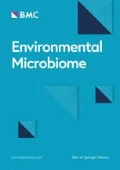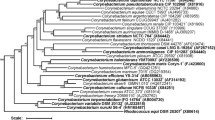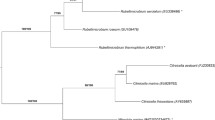Abstract
Corynebacterium maris Coryn-1T Ben-Dov et al. 2009 is a member of the genus Corynebacterium which contains Gram-positive, non-spore forming bacteria with a high G+C content. C. maris was isolated from the mucus of the Scleractinian coral Fungia granulosa and belongs to the aerobic and non-haemolytic corynebacteria. It displays tolerance to salts (up to 10%) and is related to the soil bacterium Corynebacterium halotolerans. As this is a type strain in a subgroup of Corynebacterium without complete genome sequences, this project, describing the 2.78 Mbp long chromosome and the 45.97 kbp plasmid pCmaris1, with their 2,584 protein-coding and 67 RNA genes, will aid the Genomic Encyclopedia of Bacteria and Archaea project.
Similar content being viewed by others
Introduction
Strain Coryn-1T (= DSM 45190T) is the type strain of the species Corynebacterium maris originally isolated from the mucus of the coral Fungia granulosa from the Gulf of Eilat (Red Sea, Israel) [1]. The genus Corynebacterium is comprised of Gram-positive bacteria with a high G+C content. It currently contains over 80 members [2] isolated from diverse backgrounds like human clinical samples [3] and animals [4], but also from soil [5] and ripening cheese [6].
Within this diverse genus, C. maris has been proposed to form a distinct lineage with C. halotolerans YIM 70093T demonstrating 94% similarity related to the 16S rRNA gene sequences [1]. Similar to the closest phylogenetic relative C. halotolerans, which displays the highest resistance to salt described for the genus Corynebacterium to date, C. maris Coryn-1T is able to live under conditions with high salinity. This species grows on LB agar plates with salinity ranging between 0 and 10%. Optimal growth was detected between 0.5 and 4.0% [1]. Aside from this Coryn-1T is an alkaline-tolerant bacterium, which grows well at pH 7.2–9.0 (optimum pH 7.2) [1].
Here we present a summary classification and a set of features for C. maris DSM 45190T, together with the description of the genomic sequencing and annotation.
Classification and features
A representative genomic 16S rRNA sequence of C. maris DSM 45190T was compared to the Ribosomal Database Project database [7] confirming the initial taxonomic classification. C. maris shows highest similarity to C. halotolerans (94%). Because sequence similarity greater than 97% was not obtained with any member of the genus Corynebacteria, it was suggested that C. maris forms an new novel species, a hypothesis that is backed by other taxonomic classifiers [1].
Figure 1 shows the phylogenetic neighborhood of C. maris in a 16S rRNA based tree. Within the larger group containing furthermore the species C. marinum 7015T [10] and C. humireducens MFC-5T [11], the two strains C. maris and C. halotolerans YIM 70093T [1] were clustered in a common subgroup.
Phylogenetic tree highlighting the position of C. maris relative to type strains of other species within the genus Corynebacterium. Species with at least one publicly available genome sequence (not necessarily the type strain) are highlighted in bold face. The tree is based on sequences aligned by the RDP aligner and utilizes the Jukes-Cantor corrected distance model to construct a distance matrix based on alignment model positions without alignment inserts, using a minimum comparable position of 200. The tree is built with RDP Tree Builder, which utilizes Weighbor [8] with an alphabet size of 4 and length size of 1,000. The building of the tree also involves a bootstrapping process repeated 100 times to generate a majority consensus tree [9]. Rhodococcus equi (X80614) was used as an outgroup.
C. maris Coryn-1T is a Gram-positive coccobacillus, which is 0.8–1.5 εm long and 0.5–0.8 εm wide (Table 1, Figure 2). By reason that C. maris contains a thick peptidoglycan layer, the cells commonly do not separate after cell-division and stay diplo-cellular [1], the so called snapping division.
It is described as non-motile [1], which coincides with a complete lack of genes associated with ‘cell motility’ (functional category N in COGs table).
Optimal growth of Coryn-1T was shown between 0.5 and 4.0% (w/v) salinity (NaCl or sea-salt mixture); however, ranges between 0 and 10% salinity are accepted [1]. C. maris grows at temperatures between 26–37 °C (optimum at 35 °C). Carbon sources utilized by strain Coryn-1T include maltose, lactulose, β-hydroxybutyric acid, α-ketovaleric acid, Tween 40, phenylethylamine, N-acetyl-d-galactosamine, malonic acid, l-threonine, l-glutamic acid, l-fucose, l-alanyl glycine, inosine, raffinose, d-arabitol, l-asparigine and citric acid were used weakly [1].
Coryn-1T is susceptible to sulfamethoxazole/trimethoprim, tetracycline, chloramphenicol, erythromycin, ampicillin and meticillin. The strain is resistant to nalidixic acid [1].
Chemotaxonomy
In C. maris cellular fatty acids are composed of 58% oleic acid (C18:1ω9c), 30% palmitic acid (C16:0) and 12% tuberculostearic acid 10-methyl (C18:0). The mycolic acids of C. maris are short-chained, like many but not all corynemycol acids (6% C30, 27% C32, 47% C34 and 20% C36).
The biochemical characterization by Ben-Dov et al. [1] revealed positive signals for the following enzymes/reactions: alkaline phosphatase, esterase (C4), esterase lipase (C8), lipase (C14), leucine arylamidase, α-glucosidase, pyrazinamidase, pyrrolidonyl arylamidase, and gelatin hydrolysis activities.
Genome sequencing and annotation
Genome project history
Because of its phylogenetic position and interesting capabilities, i.e. high salt tolerance, C. maris Coryn-1T was selected for sequencing as part of a project to define the core genome and pan genome of the non-pathogenic corynebacteria. While not being part of the Genomic Encyclopedia of Bacteria and Archaea (GEBA) project [23], sequencing of the type strain will nonetheless aid the GEBA effort. The genome project is deposited in the Genomes OnLine Database [24] and the complete genome sequence is deposited in GenBank. Sequencing, finishing and annotation were performed by the Center of Biotechnology (CeBiTec). A summary of the project information is shown in Table 2.
Growth conditions and DNA isolation
C. maris strain Coryn-1T, DSM 45190, was grown aerobically in LB broth (Carl Roth GmbH, Karlsruhe, Germany) at 37 °C. DNA was isolated from ∼ 108 cells using the protocol described by Tauch et al. 1995 [25].
Genome sequencing and assembly
A WGS library was prepared using the Illumina-Compatible Nextera DNA Sample Prep Kit (Epicentre, WI, U.S.A) according to the manufacturer’s protocol. The library was sequenced in a 2 × 150 bp paired read run on the MiSeq platform, yielding 1,238,702 total reads, providing 56.45× coverage of the genome. Reads were assembled using the Newbler assembler v2.6 (Roche). The initial Newbler assembly consisted of 26 contigs in seven scaffolds. Analysis of the seven scaffolds revealed one to be an extrachromosomal element (plasmid pCmaris1), five to make up the chromosome with the remaining one containing the four copies of the RRN operon which caused the scaffold breaks. The scaffolds were ordered based on alignments to the complete genome of C. halotolerans [26] and subsequent verification by restriction digestion, Southern blotting and hybridization with a 16S rDNA specific probe.
The Phred/Phrap/Consed software package [27–30] was used for sequence assembly and quality assessment in the subsequent finishing process. After the shotgun stage, gaps between contigs were closed by editing in Consed (for repetitive elements) and by PCR with subsequent Sanger sequencing (IIT Biotech GmbH, Bielefeld, Germany). A total of 67 additional reactions were necessary to close gaps not caused by repetitive elements.
Genome annotation
Gene prediction and annotation were done using the PGAAP pipeline [31]. Genes were identified using GeneMark [32], GLIMMER [33], and Prodigal [34]. For annotation, BLAST searches against the NCBI Protein Clusters Database [35] are performed and the annotation is enriched by searches against the Conserved Domain Database [36] and subsequent assignment of coding sequences to COGs. Non-coding genes and miscellaneous features were predicted using tRNAscan-SE [37], Infernal [38], RNAMMer [39], Rfam [40], TMHMM [41], and SignalP [42].
Genome properties
The genome (on the scale of 2,833,547 bp) includes one circular chromosome of 2,787,574 bp (66.67% G+C content) and one plasmid of 45,973 bp (61.32% G+C content, [Figure 3]). For chromosome and plasmid, a total of 2,653 genes were predicted, 2,584 of which are protein coding genes. The remaining were annotated as hypothetical proteins. A total of 1,494 (57,82%) of the protein coding genes were assigned to a putative function. Of the protein coding genes, 1,067 belong to 350 paralogous families in this genome corresponding to a gene content redundancy of 41.29%. The properties and the statistics of the genome are summarized in Tables 3 and 4.
References
Ben-Dov E, Ben Yosef DZ, Pavlov V, Kushmaro A. Corynebacterium maris sp. nov., a marine bacterium isolated from the mucus of the coral Fungia granulosa. Int J Syst Evol Microbiol 2009; 59:2458–2463. PubMed http://dx.doi.org/10.1099/ijs.0.007468-0
Euzéby JP. List of Bacterial Names with Standing in Nomenclature: a folder available on the Internet. Int J Syst Bacteriol 1997; 47:590–592. PubMed http://dx.doi.org/10.1099/00207713-47-2-590
Renaud FNR, Aubel D, Riegel P, Meugnier H, Bollet C. Corynebacterium freneyi sp. nov., alpha-glucosidase-positive strains related to Corynebacterium xerosis. Int J Syst Evol Microbiol 2001; 51:1723–1728. PubMed http://dx.doi.org/10.1099/00207713-51-5-1723
Collins MD, Hoyles L, Foster G, Falsen E. Corynebacterium caspium sp. nov., from a Caspian seal (Phoca caspica). Int J Syst Evol Microbiol 2004; 54:925–928. PubMed http://dx.doi.org/10.1099/ijs.0.02950-0
Zhou Z, Yuan M, Tang R, Chen M, Lin M, Zhang W. Corynebacterium deserti sp. nov., isolated from desert sand. Int J Syst Evol Microbiol 2012; 62:791–794. PubMed http://dx.doi.org/10.1099/ijs.0.030429-0
Brennan NM, Brown R, Goodfellow M, Ward AC, Beresford TP, Simpson PJ, Fox PF, Cogan TM. Corynebacterium mooreparkense sp. nov. and Corynebacterium casei sp. nov., isolated from the surface of a smear-ripened cheese. Int J Syst Evol Microbiol 2001; 51:843–852. PubMed http://dx.doi.org/10.1099/00207713-51-3-843
Cole JR, Wang Q, Cardenas E, Fish J, Chai B, Farris RJ, Kulam-Syed-Mohideen AS, McGarrell DM, Marsh T, Garrity GM, et al. The Ribosomal Database Project: improved alignments and new tools for rRNA analysis. Nucleic Acids Res 2009; 37(Database issue):D141–D145. PubMed http://dx.doi.org/10.1093/nar/gkn879
Bruno WJ, Socci ND, Halpern AL. Weighted neighbor joining: a likelihood-based approach to distance-based phylogeny reconstruction. Mol Biol Evol 2000; 17:189–197. PubMed http://dx.doi.org/10.1093/oxfordjournals.molbev.a 026231
Cole JR, Chai B, Farris RJ, Wang Q, Kulam-Syed-Mohideen AS, McGarrell DM, Bandela AM, Cardenas E, Garrity GM, Tiedje JM. The ribosomal database project (RDP-II): introducing myRDP space and quality controlled public data. Nucleic Acids Res 2007; 35(Database issue):D169–D172. PubMed http://dx.doi.org/10.1093/nar/gkl889
Du ZJ, Jordan EM, Rooney AP, Chen GJ, Austin B. Corynebacterium marinum sp. nov. isolated from coastal sediment. Int J Syst Evol Microbiol 2010; 60:1944–1947. PubMed http://dx.doi.org/10.1099/ijs.0.018523-0
Wu CY, Zhuang L, Zhou SG, Li FB, He J. Corynebacterium humireducens sp. nov., an alkaliphilic, humic acid-reducing bacterium isolated from a microbial fuel cell. Int J Syst Evol Microbiol 2011; 61:882–887. PubMed http://dx.doi.org/10.1099/ijs.0.020909-0
Field D, Garrity G, Gray T, Morrison N, Selengut J, Sterk P, Tatusova T, Thomson N, Allen MJ, Angiuoli SV, et al. The minimum information about a genome sequence (MIGS) specification. Nat Biotechnol 2008; 26:541–547. PubMed http://dx.doi.org/10.1038/nbt1360
Woese CR, Kandler O, Wheelis ML. Towards a natural system of organisms: proposal for the domains Archaea, Bacteria, and Eucarya. Proc Natl Acad Sci USA 1990; 87:4576–4579. PubMed http://dx.doi.org/10.1073/pnas.87.12.4576
Garrity GM, Holt JG. The Road Map to the Manual. In: Garrity GM, Boone DR, Castenholz RW (eds), Bergey’s Manual of Systematic Bacteriology, Second Edition, Volume 1, Springer, New York, 2001, p. 119–169.
Stackebrandt E, Rainey FA, Ward-Rainey NL. Proposal for a New Hierarchic Classification System, Actinobacteria classis nov. Int J Syst Bacteriol 1997; 47:479–491. http://dx.doi.org/10.1099/00207713-47-2-479
Zhi XY, Li WJ, Stackebrandt E. An update of the structure and 16S rRNA gene sequence-based definition of higher ranks of the class Actinobacteria, with the proposal of two new suborders and four new families and emended descriptions of the existing higher taxa. Int J Syst Evol Microbiol 2009; 59:589–608. PubMed http://dx.doi.org/10.1099/ijs.0.65780-0
Skerman VBD, McGowan V, Sneath PHA. Approved Lists of Bacterial Names. Int J Syst Bacteriol 1980; 30:225–420. http://dx.doi.org/10.1099/00207713-30-1-225
Buchanan RE. Studies in the nomenclature and classification of bacteria. II. The primary subdivisions of the Schizomycetes. J Bacteriol 1917; 2:155–164. PubMed
Lehmann KB, Neumann R. Lehmann’s Medizin, Handatlanten. X Atlas und Grundriss der Bakteriologie und Lehrbuch der speziellen bakteriologischen Diagnostik., Fourth Edition, Volume 2, J.F. Lehmann, München, 1907, p. 270.
Bernard KA, Wiebe D, Burdz T, Reimer A, Ng B, Singh C, Schindle S, Pacheco AL. Assignment of Brevibacterium stationis (ZoBell and Upham 1944) Breed 1953 to the genus Corynebacterium, as Corynebacterium stationis comb. nov., and emended description of the genus Corynebacterium to include isolates that can alkalinize citrate. Int J Syst Evol Microbiol 2010; 60:874–879. PubMed http://dx.doi.org/10.1099/ijs.0.012641-0
Lehmann KB, Neumann R. Atlas und Grundriss der Bakteriologie und Lehrbuch der speziellen bakteriologischen Diagnostik, First Edition, J.F. Lehmann, München, 1896, p. 1–448.
Ashburner M, Ball CA, Blake JA, Botstein D, Butler H, Cherry JM, Davis AP, Dolinski K, Dwight SS, Eppig JT, et al. Gene ontology: tool for the unification of biology. The Gene Ontology Consortium. Nat Genet 2000; 25:25–29. PubMed http://dx.doi.org/10.1038/75556
Wu D, Hugenholtz P, Mavromatis K, Pukall R, Dalin E, Ivanova NN, Kunin V, Goodwin L, Wu M, Tindall BJ, et al. A phylogeny-driven genomic encyclopaedia of Bacteria and Archaea. Nature 2009; 462:1056–1060. PubMed http://dx.doi.org/10.1038/nature08656
Liolios K, Chen IM, Mavromatis K, Tavernarakis N, Hugenholtz P, Markowitz VM, Kyrpides NC. The Genomes OnLine Database (GOLD) in 2009: status of genomic and metagenomic projects and their associated metadata. Nucleic Acids Res 2010; 38:D346–D354. PubMed http://dx.doi.org/10.1093/nar/gkp848
Tauch A, Kassing F, Kalinowski J, Pühler A. The Corynebacterium xerosis composite transposon Tn5432 consists of two identical insertion sequences, designated IS1249, flanking the erythromycin resistance gene ermCX. Plasmid 1995; 34:119–131. PubMed http://dx.doi.org/10.1006/plas.1995.9995
Rückert C, Albersmeier A, Al-Dilaimi A, Niehaus K, Szczepanowski R, Kalinowski J. Genome sequence of the halotolerant bacterium Corynebacterium halotolerans type strain YIM 70093(T) (= DSM 44683(T)). Stand Genomic Sci 2012; 7:284–293. PubMed http://dx.doi.org/10.4056/sigs.3236691
Ewing B, Green P. Base-calling of automated sequencer traces using phred. II. Error probabilities. Genome Res 1998; 8:175–185. PubMed http://dx.doi.org/10.1101/gr.8.3.175
Gordon D, Abajian C, Green P. Consed: a graphical tool for sequence finishing. Genome Res 1998; 8:195–202. PubMed http://dx.doi.org/10.1101/gr.8.3.195
Gordon D. Viewing and editing assembled sequences using Consed. Curr Protoc Bioinformatics 2003;Chapter 11:Unit11 2.
Ewing B, Hillier L, Wendl MC, Green P. Base-calling of automated sequencer traces using phred. I. Accuracy assessment. Genome Res 1998; 8:175–185. PubMed http://dx.doi.org/10.1101/gr.8.3.175
NCBI. 2010 NCBI Prokaryotic Genomes Automatic Annotation Pipeline (PGAAP). http://www.ncbi.nlm.nih.gov/genomes/static/Pipeline.html.
Borodovsky M, Mills R, Besemer J, Lomsadze A. Prokaryotic gene prediction using GeneMark and GeneMark.hmm. Curr Protoc Bioinformatics 2003;Chapter 4:Unit4 5.
Delcher AL, Harmon D, Kasif S, White O, Salzberg SL. Improved microbial gene identification with GLIMMER. Nucleic Acids Res 1999; 27:4636–4641. PubMed http://dx.doi.org/10.1093/nar/27.23.4636
Hyatt D, Chen GL, Locascio PF, Land ML, Larimer FW, Hauser LJ. Prodigal: prokaryotic gene recognition and translation initiation site identification. BMC Bioinformatics 2010; 11:119. PubMed http://dx.doi.org/10.1186/1471-2105-11-119
Klimke W, Agarwala R, Badretdin A, Chetvernin S, Ciufo S, Fedorov B, Kiryutin B, O’Neill K, Resch W, Resenchuk S, et al. The National Center for Biotechnology Information’s Protein Clusters Database. Nucleic Acids Res 2009; 37(Database issue):D216–D223. PubMed http://dx.doi.org/10.1093/nar/gkn734
Marchler-Bauer A, Anderson JB, Chitsaz F, Derbyshire MK, DeWeese-Scott C, Fong JH, Geer LY, Geer RC, Gonzales NR, Gwadz M, et al. CDD: specific functional annotation with the Conserved Domain Database. Nucleic Acids Res 2009; 37(Database issue):D205–D210. PubMed http://dx.doi.org/10.1093/nar/gkn845
Lowe TM, Eddy SR. tRNAscan-SE: a program for improved detection of transfer RNA genes in genomic sequence. Nucleic Acids Res 1997; 25:955–964. PubMed
Eddy SR. A memory-efficient dynamic programming algorithm for optimal alignment of a sequence to an RNA secondary structure. BMC Bioinformatics 2002; 3:18. PubMed http://dx.doi.org/10.1186/1471-2105-3-18
Lagesen K, Hallin P, Rodland EA, Staerfeldt HH, Rognes T, Ussery DW. RNAmmer: consistent and rapid annotation of ribosomal RNA genes. Nucleic Acids Res 2007; 35:3100–3108. PubMed http://dx.doi.org/10.1093/nar/gkm160
Griffiths-Jones S, Moxon S, Marshall M, Khanna A, Eddy SR, Bateman A. Rfam: annotating non-coding RNAs in complete genomes. Nucleic Acids Res. 2005;33 Database Issue:D121–124.
Krogh A, Larsson B, von Heijne G, Sonnhammer EL. Predicting transmembrane protein topology with a hidden Markov model: application to complete genomes. J Mol Biol 2001; 305:567–580. PubMed http://dx.doi.org/10.1006/jmbi.2000.4315
Bendtsen JD, Nielsen H, von Heijne G, Brunak S. Improved prediction of signal peptides: SignalP 3.0. J Mol Biol 2004; 340:783–795. PubMed http://dx.doi.org/10.1016/j.jmb.2004.05.028
Acknowledgements
Christian Rückert acknowledges funding through a grant by the Federal Ministry for Eduction and Research (0316017A) within the BioIndustry2021 initiative.
Author information
Authors and Affiliations
Corresponding author
Rights and permissions
This article is published under an open access license. Please check the 'Copyright Information' section either on this page or in the PDF for details of this license and what re-use is permitted. If your intended use exceeds what is permitted by the license or if you are unable to locate the licence and re-use information, please contact the Rights and Permissions team.
About this article
Cite this article
Schaffert, L., Albersmeier, A., Bednarz, H. et al. Genome sequence of the marine bacterium Corynebacterium maris type strain Coryn-1T (= DSM 45190T). Stand in Genomic Sci 8, 516–524 (2013). https://doi.org/10.4056/sigs.4057796
Published:
Issue Date:
DOI: https://doi.org/10.4056/sigs.4057796







